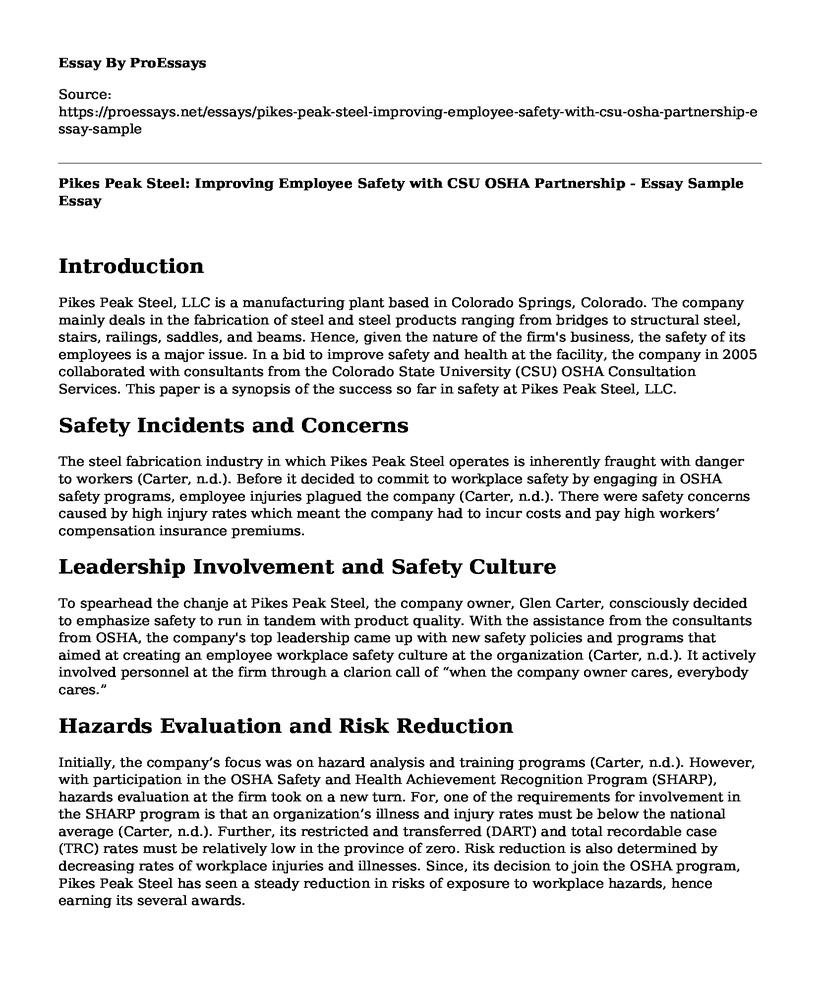Introduction
Pikes Peak Steel, LLC is a manufacturing plant based in Colorado Springs, Colorado. The company mainly deals in the fabrication of steel and steel products ranging from bridges to structural steel, stairs, railings, saddles, and beams. Hence, given the nature of the firm's business, the safety of its employees is a major issue. In a bid to improve safety and health at the facility, the company in 2005 collaborated with consultants from the Colorado State University (CSU) OSHA Consultation Services. This paper is a synopsis of the success so far in safety at Pikes Peak Steel, LLC.
Safety Incidents and Concerns
The steel fabrication industry in which Pikes Peak Steel operates is inherently fraught with danger to workers (Carter, n.d.). Before it decided to commit to workplace safety by engaging in OSHA safety programs, employee injuries plagued the company (Carter, n.d.). There were safety concerns caused by high injury rates which meant the company had to incur costs and pay high workers’ compensation insurance premiums.
Leadership Involvement and Safety Culture
To spearhead the chanje at Pikes Peak Steel, the company owner, Glen Carter, consciously decided to emphasize safety to run in tandem with product quality. With the assistance from the consultants from OSHA, the company's top leadership came up with new safety policies and programs that aimed at creating an employee workplace safety culture at the organization (Carter, n.d.). It actively involved personnel at the firm through a clarion call of “when the company owner cares, everybody cares.”
Hazards Evaluation and Risk Reduction
Initially, the company’s focus was on hazard analysis and training programs (Carter, n.d.). However, with participation in the OSHA Safety and Health Achievement Recognition Program (SHARP), hazards evaluation at the firm took on a new turn. For, one of the requirements for involvement in the SHARP program is that an organization’s illness and injury rates must be below the national average (Carter, n.d.). Further, its restricted and transferred (DART) and total recordable case (TRC) rates must be relatively low in the province of zero. Risk reduction is also determined by decreasing rates of workplace injuries and illnesses. Since, its decision to join the OSHA program, Pikes Peak Steel has seen a steady reduction in risks of exposure to workplace hazards, hence earning its several awards.
Metric of Success and Sustainability
The standard of measuring success entails a continued emphasis on quality and safety programs and an ongoing or sustained transformation in both quality and safety (Carter, n.d.). These units are the measurements and goals of performance. So far, Pikes Peak Steel's dedication to quality and safety in its fabrication works has led to helped keep error rates and workplace injuries to low. A steady reduction in reported DART and TRC rates is also a metric of success at the company. To sustain this success, the company has continued to emphasize the safety of personnel and the quality of products.
Reference
Carter, G. (n.d.). Pikes Peak Steel, LLC works with Colorado State University Osha consultation services and stays SHARP. Washington, DC: US Department of Labor, OccupationalSafety & Health Administration.
Cite this page
Pikes Peak Steel: Improving Employee Safety with CSU OSHA Partnership - Essay Sample. (2023, Aug 27). Retrieved from https://proessays.net/essays/pikes-peak-steel-improving-employee-safety-with-csu-osha-partnership-essay-sample
If you are the original author of this essay and no longer wish to have it published on the ProEssays website, please click below to request its removal:
- Social and Demographic Trends in Workstations Paper Example
- Conscious Capitalism Is Far From Dead Article Review
- Essay Sample on Unchecked Globalization: Trade Security at Risk?
- Capitalism Versus Communism: The United States Versus the Soviet Union in the Cold War Years
- Surveillance Capitalism: Data Tracking, Consumer Surveillance & Its Impact - Essay Sample
- Global Challenge: The Capacity to Decide - Research Paper
- Paper Sample on Peru Economy in 2020: GDP Declines







